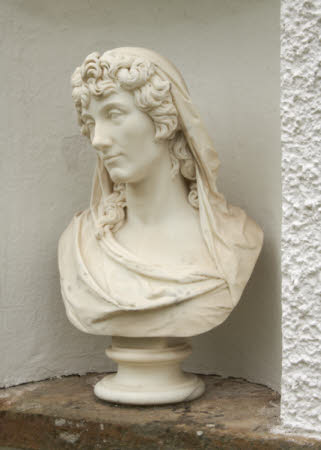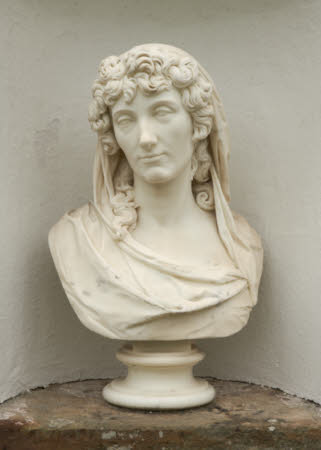A bust of the Muse of Tragedy, Melpomene, displayed as an Allegory of Autumn.
attributed to Christopher Hewetson (Thomastown c. 1736 - Rome 1798)
Category
Art / Sculpture
Date
c. 1785 - 1798
Materials
Marble on marble socle
Measurements
690 x 450 x 300 mm
Place of origin
Rome
Order this imageCollection
Ardress House, County Armagh
NT 247725.2
Summary
Sculpture, marble; Portrait bust of a woman, with vine leaves and grapes in her hair, after a Roman statue of Melpomene, the ancient Muse of Tragedy; attributed to Christopher Hewetson (c. 1736-1798); c. 1785-1798. Displayed at Ardress as ‘Autumn’, within a group of four heads depicting the Seasons.
Full description
A marble head of a young woman, her head turned sharply to her left, with thick, curling hair, crowned by a luxuriant array of vine leaves and grapes. She wears a close-fitting dress, belted at the waist. Mounted on a turned grey marble socle. The sculpture is a copy of the head and bust section of a full-length sculpture of Melpomene, the Greek and Roman Muse of Tragedy, in the Vatican Museums in Rome (Inv. 299). This was one of a group of sculptures discovered near Tivoli in 1774 which, after substantial restoration in some cases, was installed in 1784 in the Vatican in the Hall of the Muses. The nine Muses were female followers of Apollo, god of the arts, each muse representing one branch of drama, music or literature. With her plump face and wreath of grapes and vine leaves, the bust of Melpomene quite closely resembles depictions of the god of wine Bacchus, who quite often is found in art as an allegory for the season of Autumn, hence the re-use of the sculpture here as a representation of that season. It is one of four busts of females at Ardress (NT 247725.1-4) set in niches on the Garden Front of the house, which was redesigned by the second George Ensor (1772-1845). He may be presumed to have acquired the busts and to have installed them as part of the remodelling, but it is not known when and from where they came into his possession. They have long been presented as allegories of the Seasons: Spring, Summer, Autumn and Winter, and all four have hitherto been attributed to Christopher Hewetson, although in fact only the sculpture described as ‘Autumn’ (NT.24775.4) is signed by him. Although it is unsigned, it is possible that the Melpomene is also a work of Hewetson’s studio. The inventory of the contents of the studio, drawn up following the sculptor’s death on 15 November 1798, included among a substantial number of copies after the Antique, a bust of Melpomene after the Vatican statue, described in detail: ‘A copy in marble of the head of Melpomene, copied from the statue of that subject in the Clementine Museum, without a pedestal and unfinished. Valued at 55 scudi’ (‘Una copia in marmo della testa di Melpomene copiata dà quella del Clementino Museo, senza pieduccio e non terminata. Si valuta scudi cinquantacinque.’). The Melpomene is indeed mounted on a socle of quite different marble from the other busts at Ardress, which might suggest it was the copy made by Hewetson, as does also the rarity of copies of the head of the Vatican statue. Described in the inventory as unfinished, it would presumably have been completed by one of Hewetson’s assistants, perhaps Cristoforo Prosperi, who is known to have finished the portrait bust of Sir John Courtenay Throckmorton, 5th Bt (1754-1819) at Coughton Court (NT 135688). Hewetson seems to have had a particular interest in the figure of Melpomene, since the inventory also included a small-scale copy of the whole statue (Coen 2012, pp. 96-97; Suárez Huerta 2014, p. 14). Jeremy Warren June 2022
Provenance
Presumably acquired by George Ensor (1772-1845).
Marks and inscriptions
Number 1 signed on back Christopher Hewitson Fecit
Makers and roles
attributed to Christopher Hewetson (Thomastown c. 1736 - Rome 1798), sculptor Christopher Hewetson (Thomastown c. 1736 - Rome 1798), sculptor
References
Coen 2012: Paolo Coen, ‘Christopher Hewetson: Nuovi documenti, nuove interpretazioni’, Bollettino d’Arte, 7th.Series, no. 15 (2012), pp. 87-100, p. 97. Suárez Huerta 2014: Ana María Suárez Huerta, ‘Will and Inventory of Christopher Hewetson (c1737–1798)’, The British Art Journal, 15, no. 2 (2014), pp. 3-17, P. 7.



